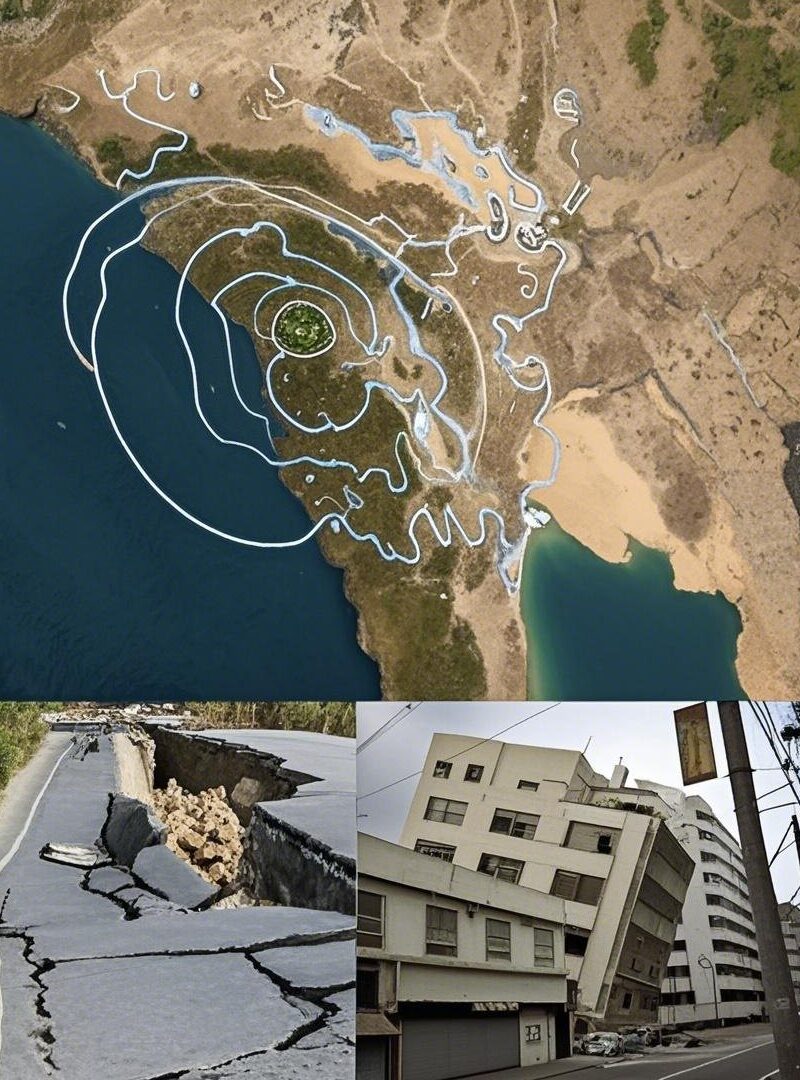Introduction
More than 23 million Americans are currently living on edge as seismologists sound the alarm: a potentially “violent” earthquake could strike at any time. This isn’t science fiction or doomsday paranoia—it’s a grounded warning based on mounting geological evidence. If you live in the western United States or even parts of the central and eastern regions, this message is for you.
The term “violent” isn’t just sensationalism—it refers to a potential earthquake capable of widespread destruction, long-lasting tremors, and life-threatening scenarios. Let’s break down what’s going on, what the experts are saying, and how you can stay safe.
What the Scientists Are Saying
The Prediction Behind the Panic
According to leading researchers, pressure along several major fault lines in the U.S.—particularly the San Andreas and the Cascadia Subduction Zone—is reaching dangerous levels. Some of these fault zones haven’t released significant energy in centuries.
Seismic Activity and the Red Flags
Recent tremors in California, Oregon, and even unexpected jolts in Texas and Tennessee are being closely monitored. These smaller quakes may be precursors, or “foreshocks,” to something much bigger.
Quotes from Leading Seismologists
Dr. Emily Carson, a seismologist at Caltech, says:
“The data doesn’t lie. We’re seeing clear patterns of stress accumulation that suggest a major quake could strike within months, if not weeks.”
The At-Risk Zones
California – The Usual Suspect
The San Andreas Fault runs through the spine of California and is long overdue for a major rupture. Scientists estimate there’s a 70% chance of a 6.7 magnitude or greater quake hitting Southern California in the next 30 years.
The Cascadia Subduction Zone
Running from Northern California through Oregon and Washington, this offshore fault has the potential to generate a quake of magnitude 9.0 or higher. The last time it did? Over 300 years ago—and it caused tsunamis.
Surprising High-Risk Areas in the Midwest and East Coast
Places like Missouri’s New Madrid Fault and even parts of South Carolina have seen unusual seismic activity. These areas aren’t immune, and their infrastructure isn’t built for earthquakes.
Understanding the “Violent” Earthquake Threat
What Does “Violent” Really Mean in Seismology?
In earthquake terms, “violent” describes ground shaking strong enough to collapse buildings, rupture pipelines, and make roads impassable. It’s not just shaking—it’s chaos.
The Potential Magnitude and Damage
Scientists warn of quakes reaching magnitudes of 7.8 or higher. That’s enough to cause billions in damage, mass evacuations, and long-term disruption.
How Long Could It Last?
While most quakes last seconds, the damage happens fast. In subduction zones, the shaking can continue for several minutes, turning cities into disaster zones.
Historical Context
Past Earthquakes That Shook the Nation
-
1989 Loma Prieta, CA – Magnitude 6.9
-
1994 Northridge, CA – Magnitude 6.7
-
1811–1812 New Madrid Series – So powerful it made the Mississippi River flow backward
Lessons Learned from Previous Disasters
In all these cases, preparedness made the difference between life and death. When people and cities weren’t ready, the toll was enormous.
Warning Signs and Preparedness
How Scientists Monitor Quakes
Seismographs, satellite data, and ground sensors constantly track earth movements. They look for patterns—clusters of micro-quakes, strange animal behavior, and soil gas changes.
What Signs Could Indicate an Impending Quake?
-
Frequent small tremors in a short time span
-
Changes in groundwater levels
-
Odd animal migrations
Can Earthquakes Be Predicted Accurately?
Sadly, no. We can forecast probabilities but not predict the exact time or location.
How Americans Are Reacting
The Fear Factor – Social Media Buzz
Twitter and TikTok are flooded with earthquake theories, survival tips, and anxiety-filled updates. Misinformation, unfortunately, runs wild during times like these.
Preparedness Kits Flying Off the Shelves
Retailers report a spike in sales of emergency food, water, and power banks. People are waking up to the real risk.
Emergency Services on High Alert
In high-risk states, emergency crews are reviewing protocols, running drills, and bracing for what could come.
Government Response and Safety Measures
FEMA’s Preparedness Plans
FEMA has been ramping up public service announcements and offering digital checklists for home and family safety.
State and Local Emergency Alerts
Many cities now have early-warning systems that can send alerts to your phone seconds before shaking begins.
Infrastructure Readiness
Bridges, tunnels, and public buildings are being evaluated for seismic resistance—though many still fall short.
What You Can Do Right Now
Creating a Family Emergency Plan
Know where to meet, who to contact, and how to turn off gas lines. Keep a copy in your wallet and one at home.
Earthquake-Proofing Your Home
Secure heavy furniture, mount TVs, and store breakables low to the ground.
Staying Informed Through Reliable Sources
Follow your local USGS office, FEMA, and state emergency services for verified updates.
Common Myths About Earthquakes
“Animals Know Before We Do”
Some believe pets can sense quakes. While anecdotal, it’s not a proven warning system.
“Big Earthquakes Only Happen in California”
Totally false. From Alaska to South Carolina, earthquakes can hit almost anywhere.
“We’ll Have Plenty of Warning Time”
Most alerts give you only seconds. Being prepared beforehand is your only real defense.
Technology and Early-Warning Systems
How ShakeAlert Works
This U.S.-based app can give users up to 60 seconds of notice before shaking begins—just enough time to take cover.
Advances in AI and Seismic Prediction
AI models are improving, helping scientists better forecast quake risks and warn the public earlier.
Apps That Could Save Lives
Downloadable apps like MyShake, QuakeAlertUSA, and Earthquake Network offer real-time alerts and safety tips.
Economic and Emotional Impact
The Cost of Earthquake Damage
Estimates show a major quake in Los Angeles could cause upwards of $300 billion in damage.
Mental Health Effects of Living in Fear
Constant worry wears on the nerves. Anxiety, insomnia, and even PTSD are common in high-risk zones.
Insurance and Financial Preparedness
Earthquake insurance is available but underutilized. Now might be the time to reconsider.
Voices from the Ground
What Residents in High-Risk Areas Are Saying
“I keep a go-bag by my front door. It’s just part of life here.”
— Marco V., San Francisco
“We never used to think about earthquakes in Missouri. Now, I check the ground before I go to sleep.”
— Julie B., St. Louis
Experts Weigh In on Staying Calm Yet Vigilant
Preparation is the best antidote to fear. Stay calm, stay ready, and stay informed.
Conclusion
The Earth isn’t waiting—and neither should we. Whether you’re in California, Oregon, or somewhere you least expect, the threat of a “violent” earthquake is real. But fear shouldn’t control you—action should. Be prepared, stay aware, and trust in the science guiding us forward. It’s not just about surviving the quake. It’s about being ready for whatever comes next.
FAQs
Q1: Can earthquakes be predicted exactly?
No. Scientists can estimate probabilities but not predict exact timing.
Q2: What should I pack in an earthquake kit?
Water, non-perishable food, flashlight, first-aid supplies, batteries, copies of ID, cash, and medications.
Q3: Is my area at risk even if I’ve never felt a quake?
Yes. Several “quiet” areas sit on fault lines with long gaps between quakes.
Q4: Are aftershocks more dangerous?
They can be. Some cause more damage than the initial quake, especially to weakened structures.
Q5: Should I evacuate if I live in a high-risk zone?
No need to evacuate unless told by authorities. Prepare, but stay where you are unless it’s unsafe.

